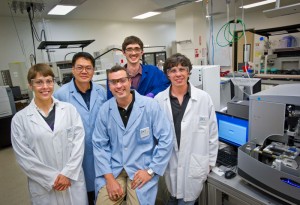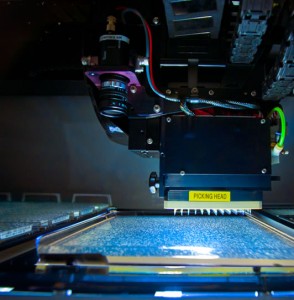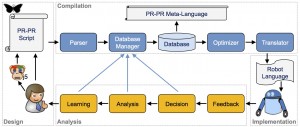Teaching a robot a new trick is a challenge. You can’t reward it with treats and it doesn’t respond to approval or disappointment in your voice. For researchers in the biological sciences, however, the future training of robots has been made much easier thanks to a new program called “PR-PR.”
Nathan Hillson, a biochemist at the U.S. Department of Energy (DOE)’s Joint BioEnergy Institute (JBEI), led the development of PR-PR, which stands for Programming a Robot. PR-PR is a simple high-level, biology-friendly, robot-programming language that allows researchers to make better use of liquid-handling robots and thereby make possible experiments that otherwise might not have been considered.
“The syntax and compiler for PR-PR are based on computer science principles and a deep understanding of biological workflows,” Hillson says. “After minimal training, a biologist should be able to independently write complicated protocols for a robot within an hour. With the adoption of PR-PR as a standard cross-platform language, hand-written or software-generated robotic protocols could easily be shared across laboratories.”
Hillson, who directs JBEI’s Synthetic Biology program and also holds an appointment with the Lawrence Berkeley National Laboratory (Berkeley Lab)’s Physical Biosciences Division, is the corresponding author of a paper describing PR-PR that appears in the American Chemical Society journal Synthetic Biology. The paper was titled “PaR-PaR Laboratory Automation Platform.” Co-authors are Gregory Linshiz, Nina Stawski, Sean Poust, Changhao Bi and Jay Keasling.
Using robots to perform labor-intensive multi-step biological tasks, such as the construction and cloning of DNA molecules, can increase research productivity and lower costs by reducing experimental error rates and providing more reliable and reproducible experimental data. To date, however, automation companies have targeted the highly-repetitive industrial laboratory operations market while largely ignoring the development of flexible easy-to-use programming tools for dynamic non-repetitive research environments. As a consequence, researchers in the biological sciences have had to depend upon professional programmers or vendor-supplied graphical user interfaces with limited capabilities.

The PR-PR development team included (from left) Nina Stawski, Changhao Bi, Nathan Hillson, Sean Poust and Gregory Linshiz. (Photo by Roy Kaltschmidt)
“Our vision was for a single protocol to be executable across different robotic platforms in different laboratories, just as a single computer software program is executable across multiple brands of computer hardware,” Hillson says. “We also wanted robotics to be accessible to biologists, not just to robot specialist programmers, and for a laboratory that has a particular brand of robot to benefit from a wide variety of software and protocols.”
Hillson, who earlier led the development of a unique software program called “j5” for identifying cost-effective DNA construction strategies, says that beyond enabling biologists to manually instruct robots in a time-effective manner, PR-PR can also amplify the utility of biological design automation software tools such as j5.
“Before PR-PR, j5 only outputted protocols for one single robot platform,” Hillson says. “After PR-PR, the same protocol can now be executed on many different robot platforms.”
The PR-PR language uses an object-oriented approach that represents physical laboratory objects – including reagents, plastic consumables and laboratory devices – as virtual objects. Each object has associated properties, such as a name and a physical location, and multiple objects can be grouped together to create a new composite object with its own properties.

PR-PR makes it much easier to train robots to perform labor-intensive multi-step biological tasks. (Photo by Roy Kaltschmidt)
Actions can be performed on objects and sequences of actions can be consolidated into procedures that in turn are issued as PR-PR commands. Collections of procedural definitions can be imported into PR-PR via external modules.
“A researcher, perhaps in conjunction with biological design automation software such as j5, composes a PR-PR script that is parsed and sent to a database,” Hillson says. “The operational flow of the commands are optimized and adapted to the configuration of a specific robotic platform. Commands are then translated from the PR-PR meta-language into the robotic scripting language for execution.”
Hillson and his colleagues have developed PR-PR as open-source software freely available through its web interface on the public PR-PR webserver http://parpar.jbei.org.
“Flexible and biology-friendly operation of robotic equipment is key to its successful integration in biological laboratories, and the efforts required to operate a robot must be much smaller than the alternative manual lab work,” Hillson says. “PR-PR accomplishes all of these objectives and is intended to benefit a broad segment of the biological research community, including non-profits, government agencies and commercial companies.”
This work was primarily supported by the DOE Office of Science.
# # #
JBEI is one of three Bioenergy Research Centers established by the DOE’s Office of Science in 2007. It is a scientific partnership led by Berkeley Lab and includes the Sandia National Laboratories, the University of California campuses of Berkeley and Davis, the Carnegie Institution for Science, and the Lawrence Livermore National Laboratory. DOE’s Bioenergy Research Centers support multidisciplinary, multi-institutional research teams pursuing the fundamental scientific breakthroughs needed to make production of cellulosic biofuels, or biofuels from nonfood plant fiber, cost-effective on a national scale. For more, visit www.jbei.org
Lawrence Berkeley National Laboratory addresses the world’s most urgent scientific challenges by advancing sustainable energy, protecting human health, creating new materials, and revealing the origin and fate of the universe. Founded in 1931, Berkeley Lab’s scientific expertise has been recognized with 13 Nobel prizes. The University of California manages Berkeley Lab for the U.S. Department of Energy’s Office of Science. For more, visit www.lbl.gov.
DOE’s Office of Science is the single largest supporter of basic research in the physical sciences in the United States, and is working to address some of the most pressing challenges of our time. For more information, please visit the Office of Science website at science.energy.gov/.
Additional Information
The ACS Synthetic Biology paper by Hillson, et. al., can be viewed and downloaded here
The PR-PR software is also available at https://github.com/JBEI/prpr
To learn more about the j5 DNA construction software visit the j5 Website at http://j5.jbei.org/
